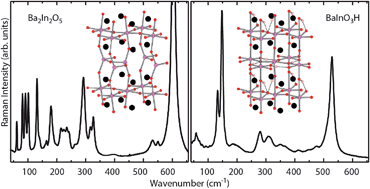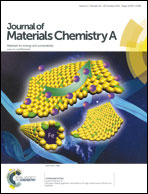Short-range structure of the brownmillerite-type oxide Ba2In2O5 and its hydrated proton-conducting form BaInO3H†
Abstract
The vibrational spectra and short-range structure of the brownmillerite-type oxide Ba2In2O5 and its hydrated form BaInO3H, are investigated by means of Raman, infrared, and inelastic neutron scattering spectroscopies together with density functional theory calculations. For Ba2In2O5, which may be described as an oxygen deficient perovskite structure with alternating layers of InO6 octahedra and InO4 tetrahedra, the results affirm a short-range structure of Icmm symmetry, which is characterized by random orientation of successive layers of InO4 tetrahedra. For the hydrated, proton conducting, form, BaInO3H, the results suggest that the short-range structure is more complicated than the P4/mbm symmetry that has been proposed previously on the basis of neutron diffraction, but rather suggest a proton configuration close to the lowest energy structure predicted by Martinez et al. [J.-R. Martinez, C. E. Moen, S. Stoelen, N. L. Allan, J. Solid State Chem., 180, 3388, (2007)]. An intense Raman active vibration at 150 cm−1 is identified as a unique fingerprint of this proton configuration.



 Please wait while we load your content...
Please wait while we load your content...